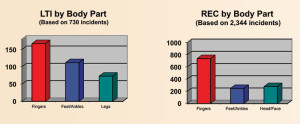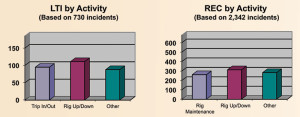IADC ISP: LTI rate holds steady in 2013, TRIR down by 8%
Latest report shows a 0.26 LTI rate, 0.81 recordable incidence rate and total of 22 fatalities
By Linda Hsieh, Managing Editor

The global drilling industry saw its lost-time incidence (LTI) rate and its number of fatalities unchanged from 2012 to 2013, at 0.26 and 22 fatalities, respectively. Improvements were visible in the 2013 total recordable incidence rate (TRIR), which improved by 8% from 0.88 to 0.81. “Activity in most sectors of the industry decreased in 2013,” Paul Breaux, IADC Director Onshore HSE, said. “Although the number of fatalities remained the same as the previous year, the overall incidence and frequency rates are still trending downward even as manhours continue to trend upward.”
Rates in this report are calculated based on incidence rates, which are calculated based on incidents per 200,000 manhours.
The IADC Incident Statistics Program (ISP) compiles data submitted voluntarily from drilling contractors. In 2013, 108 contractors participated in the ISP, representing a total of 592 million manhours worked. These companies reported a total of 2,386 recordable incidents, 743 LTIs and 22 fatalities.

In 2014, the ISP has been expanded to include well-servicing contractors; results being collected this year will be available in next year’s report. “IADC urges participation in the ISP by every drilling and well-servicing contractor around the world. Additional data would give us an even clearer picture of safety trends occurring in the industry,” Mr Breaux said. To participate, send an email to isp@iadc.org.
Fatalities

By years of service, the breakdown of fatalities is:
• 10 or more years: seven fatalities;
•5-10 years: two fatalities;
•1-5 years: five fatalities;
•6 months to 1 year: two fatalities;
•3-6 months: four fatalities.
Time in service was not reported for the remaining two fatalities.

Three of the fatalities occurred during a well control event and three during routine drilling operations. Seven fatalities were struck-by incidents, while five were due to fall-type incidents. Five of the fatalities occurred to floormen, and five fatalities occurred to motormen.
Summaries by region
Africa
Africa land and offshore operations accounted for a total of 84.58 million manhours in 2013, with three total fatalities. Onshore, the region worked 41.2 million manhours and no fatalities. Its LTI rate remained unchanged from 2012 at 0.38, but its recordable incidence rate worsened by 27% from 0.84 in 2012 to 1.07 in 2013.

Offshore Africa worked 43.38 million manhours and had three fatalities. Its LTI rate improved by 16% from 0.19 in 2012 to 0.16 in 2013, and its recordable incidence rate improved by 6% from 0.55 to 0.52.
Asia Pacific
This region accounted for 71.72 million manhours worked and a total of three fatalities. Offshore worked 48.55 million manhours with no fatalities, and its LTI rate improved by 17% from 0.18 in 2012 to 0.15 in 2013. Its recordable incidence rate also improved, going from 0.47 to 0.54, a 15% improvement. Asia Pacific’s land operations accounted for 23.17 million manhours and had three fatalities. Its 2012 LTI rate of 0.21 slightly worsened, by 5%, to 0.22 in 2013 while its recordable incidence rate improved by 11% from 1.06 to 0.94.

Canada
Drilling contractors in Canada reported a total 3.4 million manhours worked and no fatalities. Onshore Canada, 2.6 million manhours were reported with no fatalities. Its 2012 LTI rate of 0.69 improved by 12% to 0.61 in 2013, and its recordable incidence rate also improved from 2.68 to 1.98, a 26% decrease. Offshore Canada had just over 836,147 manhours and no fatalities. The offshore sector also was able to keep its 0.0 LTI rate the same for 2013. Its recordable incidence rate also improved significantly, by 83%, from 1.39 to 0.24.

Central America and Caribbean
This region accounted for 16.84 million manhours and no fatalities. Onshore contractors reported 8.7 million manhours worked. There was a 7% improvement in the LTI rate, from 0.29 in 2012 to 0.27 in 2013. The recordable incidence rate, however, worsened by 26% from 0.51 to 0.64. Offshore, this region saw just over 8.1 million manhours worked, with a 0.22 LTI rate in 2013, which is a 5% increase from 0.21 in 2012. Its recordable incidence rate improved by 7% from 0.58 to 0.54.

Europe
Land and offshore operations combined reported more than 96 million manhours worked in Europe, with a total of two fatalities. Offshore contractors in this region reported 38.7 million manhours with no fatalities. They also maintained their LTI rate at 0.27 for the third consecutive year. Recordable incidence rate only worsened by 4% from 0.82 to 0.85.
Onshore operations accounted for 58.13 million manhours with two fatalities. Both the LTI and recordable incidence rates worsened – LTI by 31% from 0.26 to 0.34 and recordable incidence by 37% from 0.35 to 0.48.

Middle East
This region accounted for 127.07 million manhours and five fatal incidents. Onshore operations made up 91.6 million manhours and four fatalities. Its LTI rate improved by 18% from 0.17 to 0.14, and its recordable incidence rate improved by 11% from 0.73 to 0.65. Offshore the Middle East, a total 35.47 million manhours were worked with one fatality. Its LTI rate worsened by 33% from 0.06 in 2012 to 0.08 in 2013 while its recordable incidence rate improved by 37% from 0.46 to 0.29.

South America
Contractors in South America accounted for 51.34 million manhours and a total of one fatality in 2013. The fatality occurred in offshore operations, which had 20.98 million manhours. Its LTI rate improved by 13% from 0.31 to 0.27, and its recordable incidence rate improved by 25% from 0.88 to 0.66.
Onshore South America, 30.36 million manhours were worked. The LTI rate in this sector improved by 6% from 0.17 to 0.16, and the recordable incidence rate worsened by 21% from 0.42 to 0.51.
United States
Land and offshore contractors combined worked more than 140.22 million manhours in the US, with eight fatalities, which all occurred in the onshore sector. US land accounted for a total 97.01 million manhours in 2013. Its LTI rate remained unchanged at 0.51. Its recordable incidence rate improved by 20% from 1.97 to 1.58. Offshore operations accounted for 43.21 million manhours. Its LTI rate improved by 21%, going from 0.19 in 2012 to 0.15 in 2013. A 16% improvement also was logged in the recordable incidence rate, which went from 0.93 to 0.78.
Click here for information of IADC’s Incident Statistics Program.




